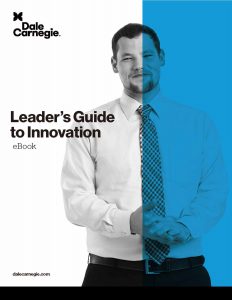Leader’s Guide to Innovation
Whitepaper on Leadership

❓ What is the Leader’s Guide to Innovation?
In today’s fast-paced business world, innovation is the difference between thriving and falling behind. Dale Carnegie Training provides leaders with a proven, step-by-step process to visualize goals, gather facts, generate ideas, and implement solutions that work.
Key Achievements of the Innovation Process
- A structured framework trusted by global business leaders
- Combines creative “green-light” thinking with disciplined “red-light” evaluation
- Strengthens team communication and collaboration
- Builds long-term organizational momentum with follow-up and evaluation
FAQ
Q1. Why is innovation important in business today?
A1. Companies must do more with less, reach new customers, and use resources wisely. Innovation is essential for staying competitive.
Q2. What makes Dale Carnegie’s innovation approach unique?
A2. It blends people-focused leadership with a clear process — from visualization to evaluation — ensuring ideas are implemented successfully.
Q3. Can teams apply this framework, or is it for individuals only?
A3. Both. Leaders can use it individually, but it is most effective when teams collaborate and build consensus.
Q4. How do we measure success after implementation?
A4. Success is measured through clear outcomes: ROI, cost savings, improved marketing, increased sales, and team alignment.
👉 From initial vision to final evaluation, Dale Carnegie’s Leader’s Guide to Innovation empowers leaders in Tokyo and around the world to turn challenges into opportunities.
Innovation doesn’t always happen naturally. That’s why a structured process is needed:
- Visualize the “should-be” state — a clear picture of the desired future.
- Find Facts about the current “as-is” state — who, what, when, where, why, how.
- Find Ideas using open, quantity-driven brainstorming.
- Find Solutions by narrowing options through criteria and consensus.
- Find Acceptance by involving others and anticipating objections.
- Implement with timelines, goals, and team accountability.
- Follow Up after 30–60 days to maintain momentum.
- Evaluate outcomes, ROI, and share results to inspire further innovation.
As Peter Drucker once said: “Innovation is the specific instrument of entrepreneurship … the act that endows resources with a new capacity to create wealth.” This guide equips leaders to make that vision a reality.




